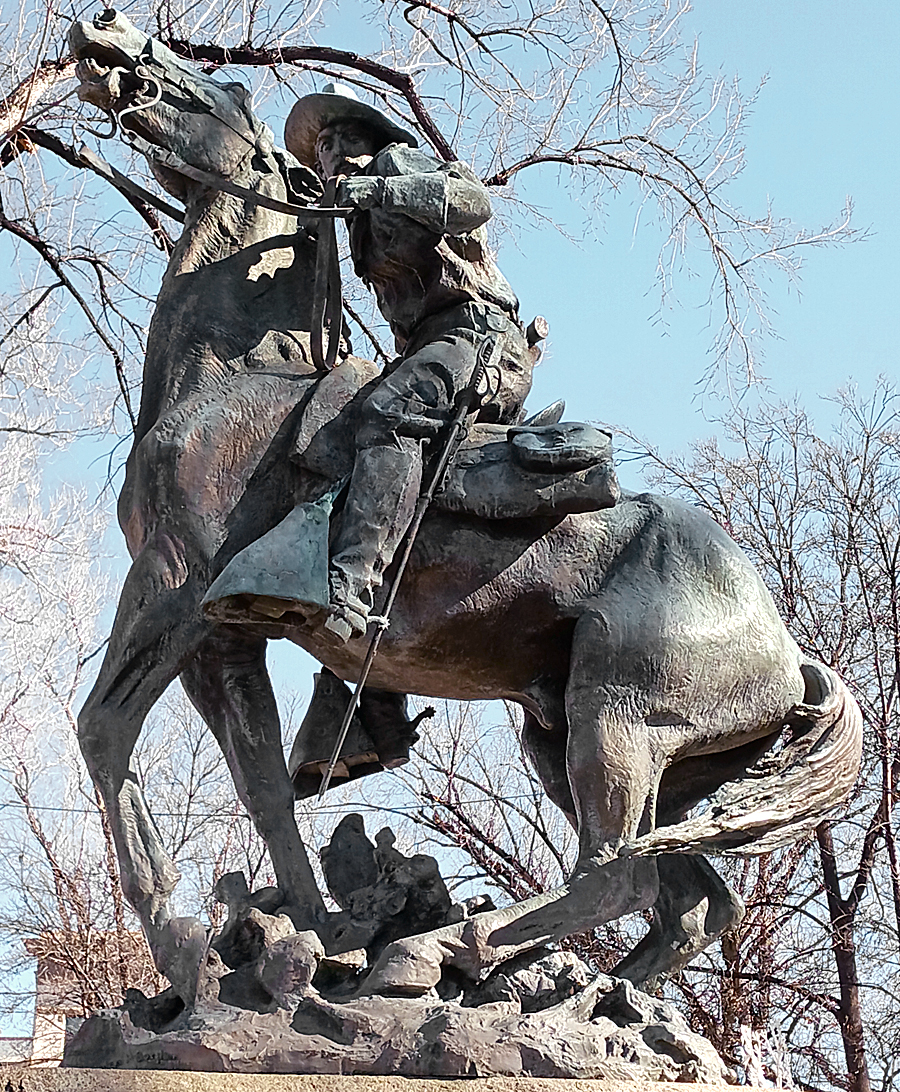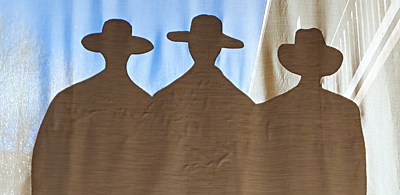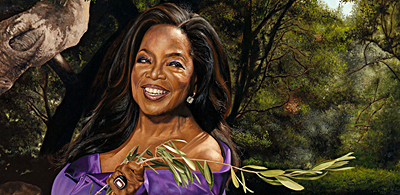A Cowboy at Rest with the Rough Riders
In December 2022 my wife Jeannine and I fled Lost Angeles, California to vacation in the wilds of Arizona. The following impressions and photos will describe our adventures in the Wild West of the Union’s 48th state. We first visited Prescott, the historic city in Yavapai County. The population of Prescott is around 45,800 souls, which is just about the number of people who live on my block in the city of LA.
We arrived at the Yavapai Courthouse Plaza, to walk around the district and take in the sights. The plaza is actually a four acre park filled with 170 trees and a beautiful historic bandstand built in 1910 (Arizona became a state in 1912). A good number of monumental bronze memorial statues are found in the plaza, two of which I’ve written about in this essay.

Courthouse Plaza is smack-dab in the center of historic downtown Prescott. Adjacent to the plaza is “Whiskey Row” or Montezuma Street. In the mid-1800s it was a block of over 40 saloons that were constructed of wood. Cowboys, miners, gamblers, outlaws, and not so pure-hearted ladies of pleasure could be found there, along with an occasional wide-eyed traveler.
You could buy beer for a nickel with gold-dust accepted as payment. It all burned down on July 14, 1900, but almost immediately the people rebuilt the area in brick and masonry stone.
One notorious saloon on Whiskey Row was The Palace. Patrons of the saloon included Doc Holliday, Wyatt and Virgil Earp, and Big Nose Kate.

Rebuilt in 1900 after the fire, the building stands today as the oldest frontier saloon in Arizona. Tarnation! The wife and I had lunch there! As a sidebar, a scene from the 1971 film Billy Jack was filmed in the Courthouse Plaza, and director Sam Peckinpah filmed scenes inside The Palace for Junior Bonner—his movie about a modern rodeo cowboy with Steve McQueen in the starring role.
After lunch at The Palace we ventured into the Courthouse Plaza to view the bronze sculptures. One such statue was Cowboy at Rest by American sculptor, Solon Hannibal Borglum (1868-1922).

Cowboy at Rest depicts a pensive cowboy at the end of his workday, stretched out in a prone position on a rocky hillside. With a slight smile on his lips he seems to be surveying the vast plains before him, his steed stands over him. The bronze is full of detail; the cowboy’s boots and spurs, an oversized bandana pulled backwards across his neck, a repeating rifle holstered in the saddle. My favorite detail though involves “woolly chaps.”


In the old days cowboys wore leather chaps to protect their legs from brush, thorns, and branding irons; some wore “woolly chaps” for the same reason. The woollies, made from thick-haired angora goatskins with the fleece left on—kept a cowboy warm in cold, wet conditions. Working cowboys today still wear chaps, and showy woollies are part of present-day rodeo.
While it looks like the horse in Cowboy at Rest is wearing “woolly chaps,” I think Solon’s cowboy hung his woollies to dry on the “stirrup fenders,” the wide leather straps that connect a saddle to the stirrups. I call this my favorite detail because Solon created in bronze the appearance of shaggy fleece, which is no mean feat.
Cowboy at Rest was originally created by Solon in 1903 as one of four small bronze statues depicting life in the West. In 1904 the artist produced a life-sized version in plaster that was exhibited at the Louisiana Purchase Exposition that same year, and in 1905 displayed at the Lewis and Clark Centennial Exposition in Portland, Oregon. Cowboy at Rest was finally cast in bronze and placed in the Yavapai Courthouse Plaza in 1990.
Solon created another famous bronze found on the grounds of the Courthouse Plaza—the Bucky O’Neill Monument, also known as the Rough Rider Monument. Art aficionados have called it the preeminent equestrian statue in America. Sure as shooting, Solon thought it to be his best work.

William Owen “Bucky” O’Neill (1860-1898) was born in Missouri and in his youth came riding into Arizona on a burro. He settled in the territory and became a favored son. He was a miner, gambler, newspaper editor, lawyer, sheriff, a Georgist (look that one up) and the mayor of Prescott. Additionally, he gained eternal fame as a captain in Theodore Roosevelt’s Rough Riders. Solon’s bronze statue is not a portrait of Bucky, but a commemoration of the Rough Riders.
Bucky was the mayor of Prescott when the Spanish American War of 1898 erupted. To fight the Spanish Empire in Cuba, Theodore Roosevelt helped to organize the 1st United States Volunteer Cavalry (the Rough Riders). Bucky organized the Arizonan volunteers who joined up, and he became Captain in a Rough Rider regiment. Highly respected by his men, Captain Bucky O’Neill was killed fighting the Spanish on July 1, 1898 in the battle at San Juan Hill.

The Yavapai county government gave the commission for the Bucky memorial to Solon in 1906. On July 3, 1907 the Bucky O’Neill Monument was unveiled in the Yavapai Courthouse Plaza and dedicated with great fanfare. Rough Rider and Civil War Veterans paraded with a marching band, along with soldiers from Fort Whipple, which in 1898 had been a mobilization area for the Rough Riders. Some 7,000 Arizonans joined with prominent citizens and the fire departments of Prescott, Tucson, and Phoenix for the massive celebration. Today the bronze still stands in the same honored place in front of the Yavapai Courthouse.
Born in Utah, Solon Hannibal Borglum grew up in Nebraska and Omaha, and spent his early years as a cowboy-rancher. Due to his talent at drawing horses, his older brother Gutzon encourage him to pursue art as a profession. The young Solon went to Omaha to study with a former student of the great realist painter Thomas Eakins, but his formal art studies were scant when he moved to Los Angeles in 1893 to paint portraits and teach art privately. I should mention that Solon’s brother Gutzon ended up creating the most American of sculptures… Mount Rushmore in South Dakota.
Finding no success in LA, Solon traveled to Ohio in 1895 and entered the Cincinnati Art Academy where he took up sculpture. The school gave him a scholarship that sent him to Paris, where he studied at the Académie Julian; the French student’s called Solon the “sculptor of the prairie.”
While at the Académie he met one of its teachers, famed American sculptor Augustus Saint-Gaudens, who gave Solon further guidance. Back from Paris, Solon gathered awards and commissions for his works depicting Cowboys, Native Americans, and life in the Old West. He established a studio in New York City, where he founded the School of American Sculpture in 1920; he lectured and taught there until his untimely death at the age of fifty-three in 1922.
Public statues like Cowboy at Rest and the Bucky O’Neill Monument, are impressive, and not just for the skills possessed by the artist. They’re a testament that Americans appreciate art that speaks to them directly in a visual language they understand—elite opinion be damned. They also preserve the nation’s history, which might be the biggest bug-a-boo to the memory-erasing mobocracy that have vandalized public statues coast to coast.
Solon Hannibal Borglum, America’s first cowboy sculptor, left the people of his country something that can’t be uprooted or broken. And for that I thank Arizona.



